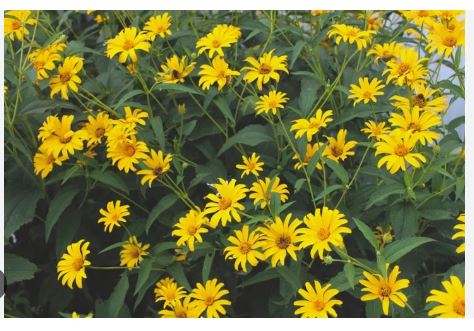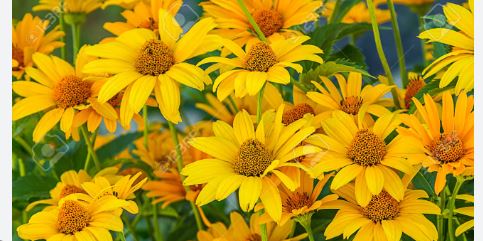
Yellow daisies, with their sunny, star-shaped blooms, bring warmth and vibrancy to any garden. Part of the Asteraceae family, these cheerful flowers come in various forms, from low-growing ground covers to tall perennials, making them perfect for borders, containers, or wildflower meadows.
Yellow daisies radiate warmth and cheer, their bright, star-shaped blooms instantly uplifting any garden. These versatile flowers, part of a diverse plant family, thrive in sunny spots, adding vibrant pops of color to borders, containers, or meadows. Their bold hue makes them a standout choice for both formal and naturalistic designs.
Most yellow daisies prefer full sun and well-drained soil, though some tolerate drought or poor conditions. They’re typically low-maintenance, requiring moderate watering and occasional deadheading to prolong their summer-to-fall blooming season. Their resilience suits gardeners of all skill levels.
These daisies attract pollinators like bees and butterflies, boosting garden biodiversity. Available as annuals or perennials, they offer flexibility for seasonal displays or long-term plantings. Their vivid color pairs beautifully with purples, whites, or reds for dynamic contrast.
Yellow daisies are excellent for cut flowers, bringing sunny charm indoors. Their adaptability to various climates and ability to self-seed in some cases ensure lasting impact. With minimal care, they deliver radiant beauty from spring through frost, brightening any landscape.

Yellow Daisies
Shasta Daisy ‘Banana Cream’ (Leucanthemum x superbum ‘Banana Cream’)
This Shasta daisy cultivar features creamy yellow blooms that fade to white, with bright yellow centers. Hardy in Zones 5-9, it grows 1-2 feet tall and blooms from summer to fall. Its compact size suits borders or containers, thriving in full sun and well-drained soil with regular watering.
Gloriosa Daisy (Rudbeckia hirta)
Also known as Black-eyed Susan, this daisy boasts golden-yellow petals with dark brown centers. A perennial in Zones 4-9, it grows 2-3 feet tall and blooms from summer to fall. Drought-tolerant and pollinator-friendly, it’s ideal for meadows or informal beds in full sun.
Tickseed Daisy (Coreopsis grandiflora)
Tickseed daisies produce large, golden-yellow blooms with toothed petals. Hardy in Zones 4-9, they grow 1-2 feet tall and bloom from summer to fall. Low-maintenance and drought-tolerant, they shine in borders or naturalistic gardens, preferring full sun and well-drained soil.
Zion Daisy (Coreopsis verticillata)
Known as threadleaf coreopsis, this daisy offers bright yellow, star-shaped blooms on wispy foliage. Hardy in Zones 3-9, it grows 1-2 feet tall and blooms from summer to fall. Its airy texture suits rock gardens or borders, thriving in full sun with minimal care.
Whorled Daisy ‘Moonbeam’ (Coreopsis verticillata ‘Moonbeam’)
This coreopsis cultivar features soft, pale yellow blooms on fine foliage. Hardy in Zones 3-9, it grows 1-2 feet tall and blooms from summer to fall. Drought-tolerant and easy to grow, it’s perfect for borders or containers in full sun with well-drained soil.
Golden Marguerite Daisy (Anthemis tinctoria)
Golden marguerites display bright yellow or cream blooms with feathery foliage. Hardy in Zones 3-7, they grow 2-3 feet tall and bloom from summer to fall. Ideal for cottage gardens or cut flowers, they thrive in full sun and well-drained soil, needing occasional pruning.
Showy Daisy (Euryops pectinatus)
Showy daisies, or bush daisies, produce vibrant yellow blooms on evergreen shrubs. Hardy in Zones 8-11, they grow 2-3 feet tall and bloom nearly year-round in warm climates. Perfect for coastal gardens or containers, they tolerate drought and prefer full sun.
Dahlberg Daisy (Thymophylla tenuiloba)
Dahlberg daisies are bushy annuals with tiny, bright yellow blooms and fern-like foliage. Growing 6-12 inches tall, they bloom from summer to fall in full sun. Drought-tolerant and ideal for borders or ground cover, they thrive in sandy, well-drained soil.
Crown Daisy (Glebionis coronaria)
This annual daisy features bright yellow blooms with matching centers. Growing 1-3 feet tall, it blooms from spring to summer in full sun. Its edible leaves and flowers make it a unique addition to herb gardens or sunny borders, preferring well-drained soil.
Butterfly Daisy (Gaillardia aristata)
Also called blanket flower, this daisy offers yellow blooms, often with red or orange bands. Hardy in Zones 3-10, it grows 1-3 feet tall and blooms from summer to fall. Drought-tolerant and pollinator-friendly, it suits borders or prairies in full sun with lean soil.
Arctotis Daisy (Arctotis hybrida)
Arctotis daisies, or African daisies, include yellow varieties with silvery-green foliage. Hardy in Zones 9-11 but grown as annuals elsewhere, they grow 12-18 inches tall and bloom from spring to summer. They’re perfect for containers or borders in full sun with well-drained soil.
Livingstone Daisy (Dorotheanthus bellidiformis)
Livingstone daisies are low-growing annuals with vibrant yellow blooms that open in sunlight. Growing 4-6 inches tall, they bloom from summer to fall in full sun. Ideal for rock gardens or as ground cover, they thrive in sandy, well-drained soil and tolerate dry conditions.
Why Choose Yellow Daisies?
Yellow daisies are a versatile addition to any garden, offering long bloom times, low maintenance, and pollinator appeal. Their bright hues create focal points or complement other colors in mixed plantings. Most thrive in full sun and well-drained soil, with regular deadheading to extend flowering. Check local regulations, as some varieties may self-seed or spread vigorously.
Tips for Growing Yellow Daisies
- Sunlight: Provide at least 6 hours of direct sun daily for optimal blooms.
- Soil: Ensure well-drained soil; amend with compost for nutrient-hungry varieties.
- Watering: Water moderately, allowing soil to dry slightly between sessions; many are drought-tolerant.
- Care: Deadhead spent blooms to encourage reblooming, divide perennials every 2-3 years, and monitor for fungal issues in humid conditions.